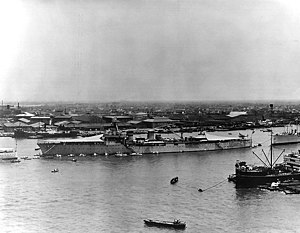 Lamotte-Picquet at Shanghai, 1939
| |
| Class overview | |
|---|---|
| Name | Duguay-Trouin class |
| Operators | |
| Preceded by |
|
| Succeeded by | Jeanne d'Arc |
| Built | 1922–1927 |
| In service | 1926–1952 |
| In commission | 1926–1952 |
| Completed | 3 |
| Lost | 2 |
| Retired | 1 |
| General characteristics | |
| Type | Light cruiser |
| Displacement |
|
| Length | 181.30 m (594.8 ft) overall |
| Beam | 17.50 m (57.4 ft) |
| Draught | 5.2 metres (17 ft) |
| Installed power |
|
| Propulsion | 4 shafts; geared steam turbines; |
| Speed | 30 knots (56 km/h; 35 mph) |
| Range | 3,000 nmi (5,600 km; 3,500 mi) at 15 knots (28 km/h; 17 mph) |
| Complement | 27 officers, 551 sailors |
| Armament |
|
| Armour |
|
| Aircraft carried |
|
The Duguay-Trouin-class were the first major French warships built after World War I. They were excellent steamers and proved successful and seaworthy over a quarter century of service. All three achieved 33 knots (61 km/h; 38 mph) on trials and could easily maintain 30 knots (56 km/h; 35 mph) in service. Twenty-year-old Duguay-Trouin could still maintain 27.7 knots (51.3 km/h; 31.9 mph) at her post-war displacement of 10,900 tons.[1] They were fast and economical, although with a limited range.[2] The fate of these three ships after the French surrender illustrates the dichotomy within the French armed forces at the time: one ship was interned, then joined the Free French, another twice resisted Allied bombardment and was destroyed, and the third was disarmed at a French colonial port and subsequently sunk.